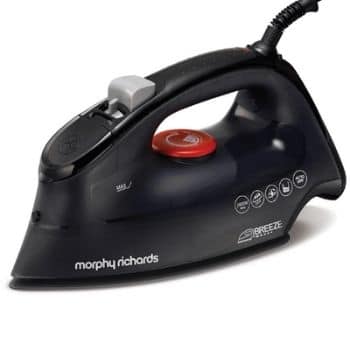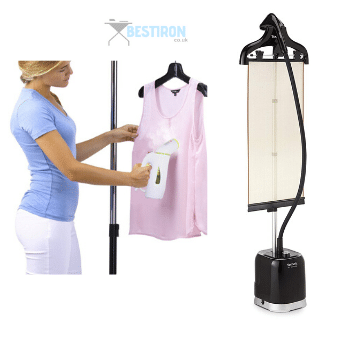Asking yourself which iron to opt for? Can’t decide whether you should invest in a regular iron or a garment steamer? We will make this decision easy for you.
Ironing the clothes is one of several household chores that you have to do once every second week after doing the laundry.
There is no denying that you have got to press your clothes to their most refined form to have a great outlook. An expressive office shirt will look like a cheap polyester fabric bought from the thrift store if you don’t remove all the stray creases and wrinkles. Therefore, it is crucial that you buy an excellent iron, with or without a steam feature.
Regular iron or Garment steamer?
This is indeed one of the most pressing questions of the current era, which one iron would do a better job of pressing a massive pile of clothes in just one go.
We will look into the properties, performance, and output of both irons to weigh out which would be the best option when it comes to making wardrobe wrinkle-free in less time, more efficiently.
Regular Clothes Iron:
A regular iron or steam iron is being designed in different ways, mostly with a triangle-shaped soleplate with or without the steam function. The tip of the soleplate may be simple or pointed, depending on each iron’s design individually.
The heat usually transfers from the flat surface of the soleplate to the fabric underneath.In order to work your way around with the regular style iron, you also need an additional accessory, which is an ironing board.

We all are well familiar with how to use an over-the-counter iron; our grandmothers and ancestors have been using it for years. Those were the halcyon days when they used to heat up the soleplate over the stove before pressing it directly onto the fabric to smooth the ceases out. Lifting the old-school iron used to be a tremendously hectic job itself, let alone moving it back and forth over the fabric to make it soother and exquisite.
Today we have access to tons of modern style models of regular irons; they all come with the same design with a few additional features. You just have to put the soleplate over the material to get rid of creases from the sleeves, collar, ruffles, and pleats.
Although you can use the iron almost on any fabric such as cotton, crepe, chenille, and polyester, you can’t obtain good results by merely using it on any fabric having more synthetic fibers and cotton in the design.
When pressing cotton or canvas, you can use a combo of vinegar and water to spray to dampen the cloth for easy ironing.
When you have a regular iron, you may require to find out a compatible size of the ironing board to make a pair for a comfortable ironing session. It could be another expense that might want you to consider a garment steamer instead.
Additionally, you can’t expect to have a quality and impeccable press with a regular iron as they may lack a pointed tip to reach all around the collar and ruffles. In the end, you will get a nicely pressed wardrobe only, with some creases just about here and there.
Tips For Using a Regular Iron:
Low Heat:
If you are ironing a delicate fabric like sheer, organza, and silk, keep the heat at the lowest temperature to start off. You can work around different heat levels once you get used to ironing. With time you will figure out what temperature is going to be the best for a particular fabric that you wish to take the wrinkles out of.
Steam function:
Nowadays, regular irons come with or without a steam function. Opt for the one containing micro or nano steam holes to achieve better ironing results. More steaming vents would offer more steam to assist with crease removal in less time than it usually takes.
Heat setting:
Every iron comes with the temperature control unless you have one with just a ‘one-temperature setting’ to go with. Adjust the heat level according to the fabric being pressed. Too much heat can result in shiny marks, or too low heat may make the crease removal a time-consuming task for you.
Protective cloth:
If you are ironing a sensitive piece of fabric with gemstones, beads, and embroidery, you can put an additional piece of cotton cloth over it to press it. Do the same when you intend to remove the stray creases from polyester, leather, or any other fabric that does not tolerate heat very well usually.
Damp with water:
Pressing a fabric like cotton could be so cumbersome as its texture is stiff and rigid. Splash a few sprays of water over the surface and set it aside for a few minutes. Iron the clothes when the water is fully soaked inside the tissues of the fabric. It will ease out ironing for you besides delivering flawless results.
Pros:
- Ideal for removing wrinkles from all types of thick clothes.
- Remove creases faster than a steamer.
- Great for a long term domestic use.
- Affordable and inexpensive.
- Dual-performance as a dry heat iron and steam iron.
- Heavy soleplate causes the wrinkles to fall out quickly.
- Steam irons flattens the fabrics, while a steamer only softens it.
Cons:
- A simple iron can’t remove odors from clothes.
- Not suitable for delicate clothes.
- Not effective for ironing ruffles, pleats, or sleeves.
- Takes more space than a garment steamer.
- Heavy weight and less portable
- Takes more energy and effort during ironing.
- It can burn the fabric when is overheated.
Garment Steamer:
A garment steamer is a modern-time handheld iron that aids in taking the fabric’s wrinkles without any direct contact.
A garment steamer comes with a water tank of varied capacity, and it shoots hot steam directly over the surface of the fabric to smooth the tissues of the fibers. A jet or nozzle emits the steam out of the device, directly towards the clothes lying either horizontally or suspended on a hanger. Some people also remember this by vertical steam iron name.

There are no chances of ending up with a scorched path of fabric using clothing steam as you maintain a safe distance while shooting the steam. The steam wand of the hose is usually located at a short distance to deliver more smoothness in less amount of time.
I would say that these irons are great for smoothing out wrinkles from very delicate and soft fabrics such as organza, satin, silk, and any other fabric that cannot be exposed to the direct heat of a regular iron.
There is no chance of the fabric or material getting burned as it’s being steamed from a fair distance rather than being exposed to any sort of heat. In addition, if the fabric is embellished with stones, gemstones, or embroidery, the creases can be removed without having to press the fabric under the iron.
All in all, a steam-generating iron is an excellent electrical device to have in your home. It can be used on fabrics that bear printing motifs and 3D designs. Moreover, it also helps remove the wrinkles from those parts that a regular iron cannot reach, such as the collar, cuffs, pleats, and ruffles.
A brilliant steam generator iron brand is Philips – they are, as always super reliable products and we have actually created a list of the best Philips handheld steamer irons with their features and pros and cons.
You cannot expose jerseys, sweaters, and tuxedo to the heat of a regular iron for the fact that it may damage the fibers and tissues underneath the layers. In this case, a garment steamer comes quite handy.
One most notable feature is that garment steamers are way more comfortable carrying, storing, and using than any regular iron. They don’t occupy much space in your home, offering the best storage solution for people living in small houses or one-bedroom apartments.
Tips For Using a Garment Steamer
Delicate fabric:
A garment steamer works best on delicate fabric. All those fabrics that cannot handle high heat and level levels should be smoothed out with it. Instead of using a regular iron on clothes having expensive stone-work, you can use the steamer only.
Printed Clothes:
Shirts and pants with printings can be revamped within minutes using this device.
Bring clothes to life:
If you feel like your cotton dress shirt still has some wrinkles to get rid of, you can use a clothing steamer to bring the fabric back to life without pressuring it yet one more time
Pros:
- Garment steamers work much faster than the clothing iron.
- They are easy to carry and use for being lightweight.
- They don’t take much space and are also travel-friendly.
- Ease of use for quick crease removal in a jiffy
- Helpful in smoothing out ruffles, cuffs, sleeves, and pleats
- Work smoothly on polyester, cotton, satin, organza and silk.
- They don’t not burn the fabric even if is overheats.
- Remove the wrinkles from hanging drapes and clothes
- Cable tidy.
Cons:
- Not best for ironing a massive pile of laundry.
- A bit more expensive than a regular iron.
- Can’t flatten the creases from the surface.
- Suitable for softening the fabric and tissues only.
- High steam exposure may cause the garment to lose its color
Last words:
For shopping malls and shops, a garment steamer is a must-have! You cannot expose your expensive clothes to the iron if they are delicate. You’d need it for softening the texture of the fabric thereby removing the visible crease from the clothes.
For homes, it’s advisable to use a regular iron as it can keep all types of your clothes wrinkle-free.

I am a content strategist and the administrator of this website. Professionally, I am an assistant Electronics professor at the University of Chester. I love to read about my profession and have a lot of interest in various home electronics appliances. Freely contact us if you have any queries regarding steam irons and other electronic devices.

